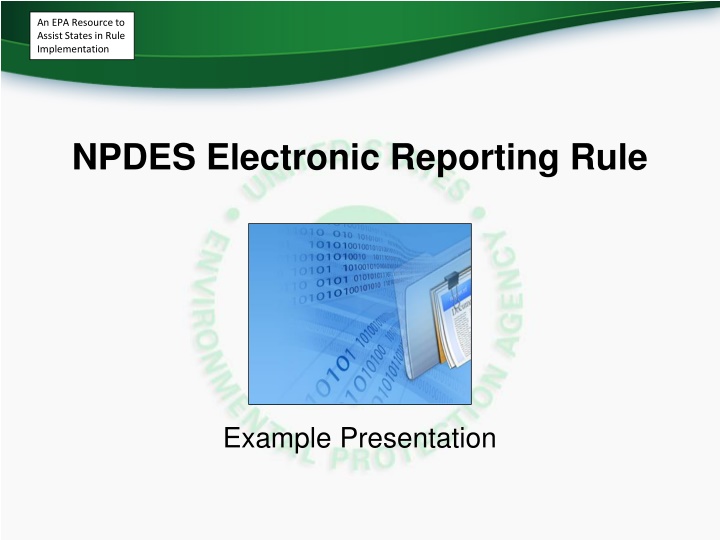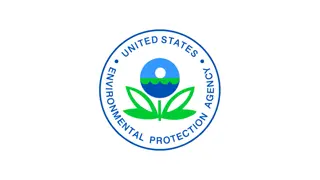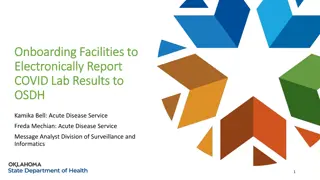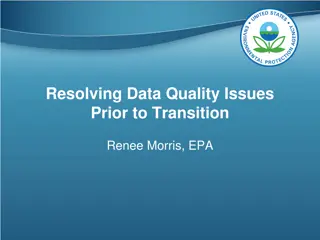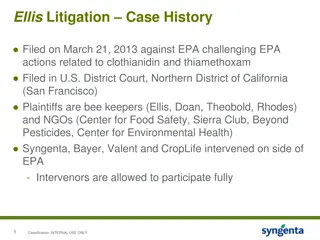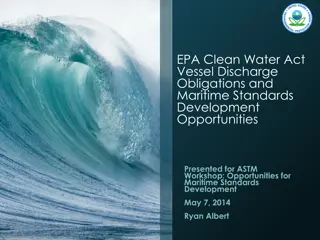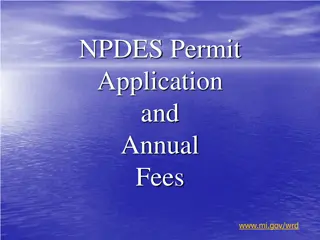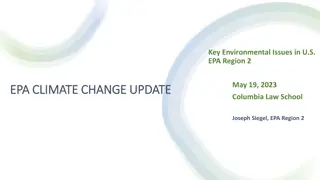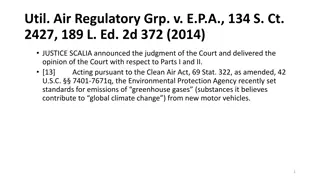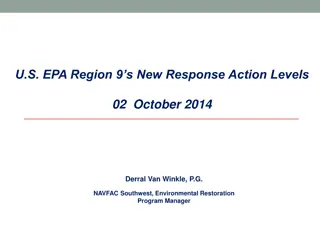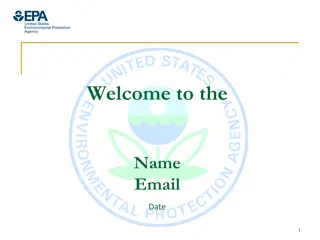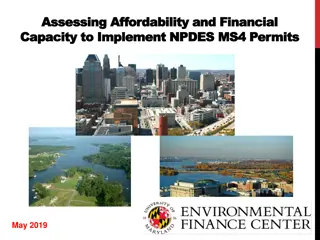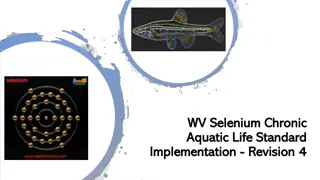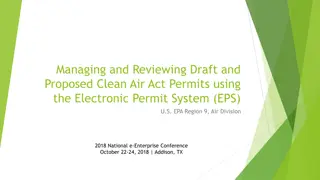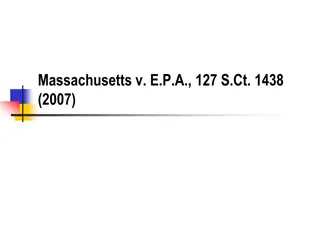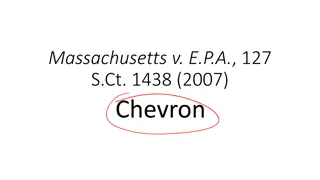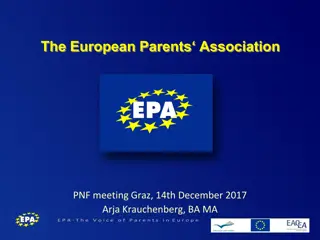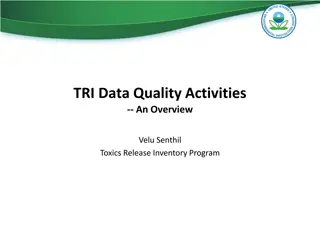EPA Resource for NPDES Rule Implementation: Electronic Reporting
This EPA resource aims to facilitate the implementation of NPDES rules through electronic reporting, benefiting the environment and reducing reporting burdens. The initiative will transition the NPDES program into the digital age, enhancing efficiency, accuracy, and transparency while saving time and costs for stakeholders.
Download Presentation

Please find below an Image/Link to download the presentation.
The content on the website is provided AS IS for your information and personal use only. It may not be sold, licensed, or shared on other websites without obtaining consent from the author.If you encounter any issues during the download, it is possible that the publisher has removed the file from their server.
You are allowed to download the files provided on this website for personal or commercial use, subject to the condition that they are used lawfully. All files are the property of their respective owners.
The content on the website is provided AS IS for your information and personal use only. It may not be sold, licensed, or shared on other websites without obtaining consent from the author.
E N D
Presentation Transcript
An EPA Resource to Assist States in Rule Implementation NPDES Electronic Reporting Rule Example Presentation
An EPA Resource to Assist States in Rule Implementation Goals of the Rulemaking This rule will help EPA and states clean up the nation s waters, by: Bringing the NPDES Program into the 21st Century by shifting from paper to electronic reporting. Final rule establishes no new reporting requirements for regulated entities. Saving money and time for the regulated community and for states (reduce data entry time, improve accuracy). Improving transparency and freeing resources to focus on the most important problems. Using technology to obtain more accurate, timely, and complete information about the NPDES program. 22 February 2016 2
An EPA Resource to Assist States in Rule Implementation NPDES-Regulated Facilities Separate Sewer Systems - including satellite systems, 20,000 Pretreatment Programs - Approved, 1,600 Biosolids Generators, 16,500 Non-Majors with Individual Permits, 39,000 CAFOs (75% may need permits), 19,000 Municipal Separate Stormwater Sewer Systems, 7,300 Combined Sewer Systems, 800 Majors, 6,700 Industrial Stormwater, 89,000 Construction Stormwater, 200,000 General Permits - 71,000 (estimate - includes duplication of facilities-e.g. ~4,000 CAFOs covered by GPs) . Note: This graph covers all discharge sources except for significant industrial users not under an Approved Pretreatment Program and dischargers operating under general permits for discharges from vessels and discharges from pesticide applicators. 22 February 2016 3
An EPA Resource to Assist States in Rule Implementation EPA Region 9 Annual Pretreatment Reports EPA Region 7 Annual Biosolids Reports 22 February 2016 4
An EPA Resource to Assist States in Rule Implementation What Does the Rule Do? Replaces much of the currently-required paper-based NPDES reporting with electronic reporting, significantly reducing reporting burden. Obtains required information directly from the source where data is generated. Reduces data entry errors by instead requiring electronic data submissions. Provides significant cost savings for states, primarily due to streamlining the processing of DMR data. Proposes to eliminate several existing state reporting requirements to EPA. 22 February 2016 5
More Efficient Data Submissions An EPA Resource to Assist States in Rule Implementation Existing NPDES Program Reporting 40 CFR Discharge Monitoring Reports (DMRs) 122.41(l)(4)(i) General Permit Reports (NOI, NOT, NECs, LEWs) 122 Data from NPDES Permittees Sewage Sludge/Biosolids Annual Program Reports 503 CAFO Annual Program Reports 122.42(e)(4) MS4 Program Reports 122.34(g)(3), 122.42(c) Pretreatment Program Annual Reports 403.12(i) Industrial User Compliance Reports in Municipalities Without Approved Pretreatment Programs When EPA or State is Control Authority 403.12(e) & (h) Sewer Overflow/Bypass Event Reports 122.41(l)(6), (7), (m) CWA 316(b) Annual Reports (Federally Listed Threatened or Endangered Species) 40 CFR 125 Subpart J Require electronic reporting by NPDES-authorized states, territories, tribes, and Regions of program implementation information (permits, inspections, violations, and enforcement actions) Data from States 123.41 & 123.43 Eliminate requirements for the annual state biosolids annual report, semi-annual statistical summary report, phase out state burden for ANCR and QNCR submissions, and rename and modify terms defining Category I and Category II noncompliance to reflect the new data sources 123.45, 501.21 22 February 2016 6
Implementation Approach An EPA Resource to Assist States in Rule Implementation Phase 1 Data (21 December 2016): EPA and states would electronically receive: Basic facility and permit information as well as inspections, violation determinations, and enforcement actions data from states; DMR information (if required) from facilities; and Sewage Sludge/Biosolids Annual Program Reports (where EPA runs the Federal biosolids program, which is 42 states, territories, and tribal lands). Phase 2 Data (21 December 2020): In addition to Phase 1 data, EPA and states would receive: general permit reports such as information (NOIs, etc.) from general permit covered facilities; and All identified program reports from facilities. States can grant temporary electronic reporting waivers (up to five years, renewable upon request by permittee). Possible use of information collection requests by EPA as a means to compel NPDES regulated entities to start electronically reporting ( fill in the gaps ). 22 February 2016 7
An EPA Resource to Assist States in Rule Implementation EPA s Electronic Reporting Tools EPA has two tools for electronically collecting permit related documents and compliance monitoring information. These tools are available for states to use for their implementation of the NPDES Electronic Reporting Rule. NetDMR Used for the collection of Discharge Monitoring Report (DMR) forms. NPDES Electronic Reporting Tool (NeT) Used for the collection of all other NPDES forms and information. 22 February 2016 8
An EPA Resource to Assist States in Rule Implementation NetDMR National Installation of NetDMR In Production Since June 2009 In production with 15 states, 8 EPA Regions, and approximately 9,000 permittees. (May 2015) States Hosted Installations of NetDMR Texas Commission on Environmental Quality (TCEQ) Nevada Division of Environmental Protection (NDEP) 22 February 2016 9
An EPA Resource to Assist States in Rule Implementation NPDES e-Reporting Tool (NeT) What is in Pilot and Production EPA Region 6 Offshore and Oil & Gas General Permit (GMG290000) Office of Water Stormwater Multi-Sector General Permit What is Next for 2016 Sewage Sludge/Biosolids Annual Program Reports State General Permits (as funding is available) 22 February 2016 10
An EPA Resource to Assist States in Rule Implementation Next Generation Compliance This rulemaking is part of a broader Agency initiative called, Next Generation Compliance. Next Generation Compliance consists of five interconnected components, each designed to improve the effectiveness of EPA s compliance program: Shift toward electronic reporting to help make environmental reporting more accurate, complete, and efficient while helping EPA and co-regulators better manage information, improve effectiveness and transparency. Expand transparency by making information more accessible to the public. Develop and use innovative enforcement approaches (e.g., data analytics and targeting) to achieve more widespread compliance. The Next Generation Compliance Strategic Plan charts EPA s path forward in the coming years: http://www2.epa.gov/compliance/next-generation-compliance 22 February 2016 11
An EPA Resource to Assist States in Rule Implementation Schedule and Next Steps Administrator McCarthy signed the final rule on Sept. 24th. The rule was published in the Federal Register on 22 October 2015 and became effective on 21 December 2015. EPA is currently working with all states and EPA regions to to them ready for Phase 1 electronic reporting (focus on DMRs and Sewage Sludge/Biosolids Annual Program Reports). 22 February 2016 12
